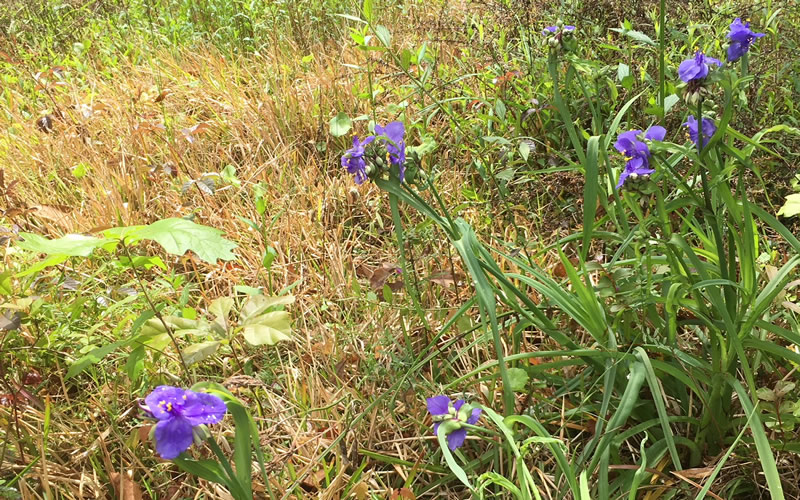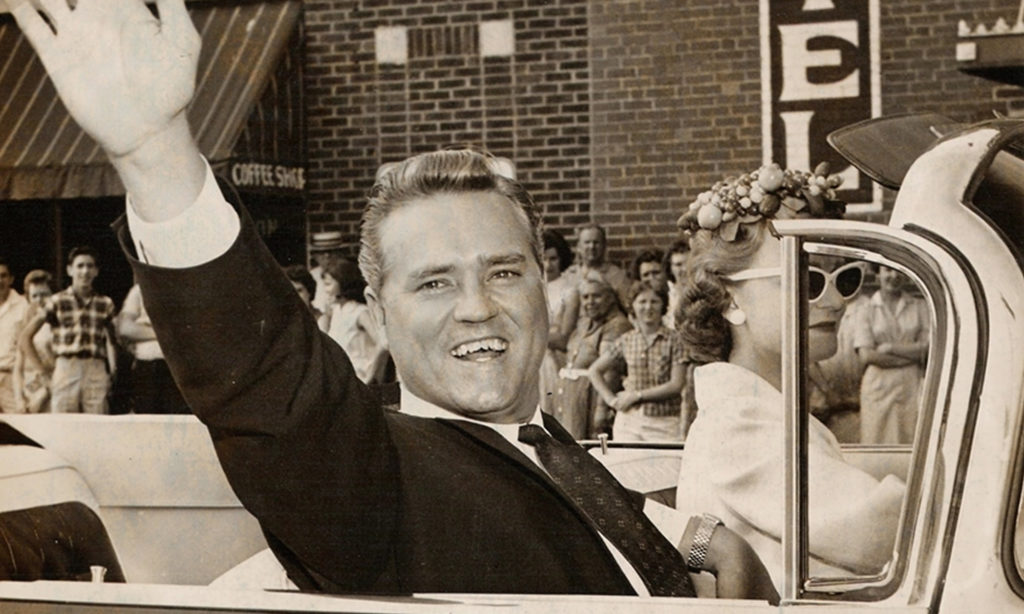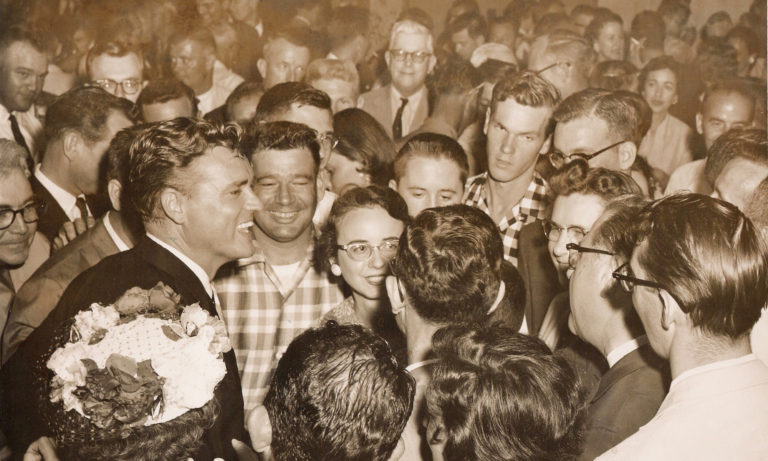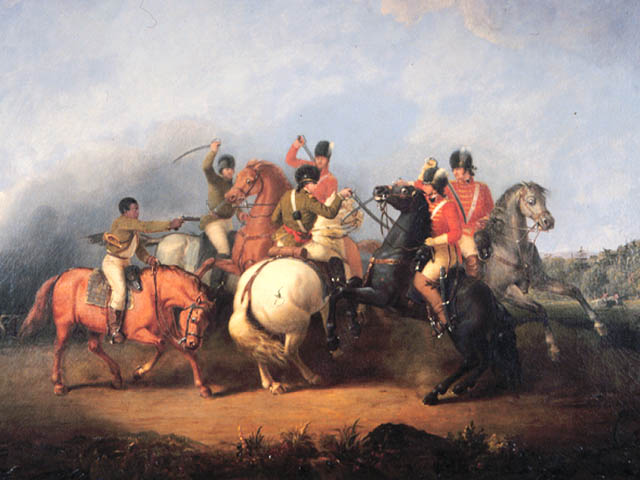Charleston Currents #11.22 | April 8, 2019
LOOK AROUND and smell the wildflowers. It’s not too hard to find wild iris these days, particularly when the sun it out. Enjoy.
COMMENTARY, Brack: Yes, senator, the ox is in the ditch stil
IN THE SPOTLIGHT: Magnolia Plantation and Gardens
REAL ESTATE: Should you buy a home warranty?
GOOD NEWS: New book highlights how S.C. can do better
FEEDBACK: Send us your thoughts
MYSTERY PHOTO: What is this photo all about?
S.C. ENCYCLOPEDIA: Battle of Cowpens was turning point in Revolutionary War
CALENDAR: Lots to do locally in weeks ahead
BRACK: Yes, senator, the ox is in the ditch still
By Andy Brack, editor and publisher | “The ox is in the ditch.”
That’s an adage frequently offered by Fritz Hollings, South Carolina’s larger-than-life former governor and United States senator who passed away April 6 at age 97.
 But what did it mean? Meet the Press host Tim Russert once asked Hollings with a twinkle in his eye.
But what did it mean? Meet the Press host Tim Russert once asked Hollings with a twinkle in his eye.
Hollings, who often used colloquial sayings to make a point, explained that when an ox hauling a wagon went into a ditch in the olden days, it took more than the ox to pull the wagon out of the ditch. It took several people working as a team to make things right.
So when Hollings, who retired in 2005 after a 38-year Senate career, talked about oxen and ditches and national budgetary, trade or jobs problems, he was saying the country needed to pull together and work as a team to get us out of a particular ditch.
And these days, we’re in a big national ditch, particularly with an untruthful president leading the country away from core values in ways no other president – Republican or Democratic –would have ever imagined. Truth, justice and the American way have been replaced by lies, recklessness and partisan tribalism. Foundational principles, such as the rule of law, seem to have been thrown out the window. The good of the country seems to have been replaced by the greed of a few.
And that’s why today’s leaders need to emulate independent, maverick and sometimes cantankerous voices like Fritz Hollings.
As a former Hollings staffer, my days since the senator’s death have been filled with lots of phone, text and email messages from longtime readers, colleagues and friends expressing condolences. And while I’m sad he is gone, I’ve suggested that people across the state and nation should celebrate his life of accomplishments.
By any measure, Hollings accomplished more in one lifetime than six normal people. As governor, he created the technical education system that provided better job opportunities and wages to hundreds of thousands of South Carolinians. He balanced the state’s budget, earning the AAA credit rating – something leaders have maintained for almost 60 years. He started SCETV, which brings education into people’s homes.
On the national level, he impacted millions of Americans. Untold numbers of mothers and children received food through the WIC program that started after his groundbreaking book, The Case Against Hunger. More than 27 million Americans today receive primary medical care in community health centers through the Health Resources & Services Administration, an $11 billion agency that he helped bring into existence. (The first two centers were in Beaufort County and Massachusetts.)
And those accomplishments were just in his first few years in the Senate. He was the father of critical environmental protection measures, trade bills, budget freezes and commerce legislation that unlocked a telecommunications revolution. The list goes on and on. (See more at FritzHollings.com.)
Hollings spent a career in public service doing the public good. He constantly strived for new ideas and better ways of doing things to fix problems created by others. He challenged colleagues to push for a better America.
And on a personal level, he was about as good of a friend as you could have. One Charlestonian recently recalled that he ran into the senator at an airport and admired his cufflinks. Hollings took them off and gave them to the man. That’s the kind of guy he was.
Fritz Hollings defined the very qualities that Americans are hungry for today – leaders who speak their minds and care about what the people need, not what big business, rich people and insiders want. They want someone who calls ‘em like they see ‘em. They want people who care more for the country than tribal sycophants looking to get past the next news cycle.
Yes, senator, the ox is still in the ditch. More than ever, we need people like you to speak their minds and lead. Thank goodness, you’ve shown us the way to move forward.
Ernest Frederick Hollings. Rest in peace.
Brack served as Hollings’ spokesman from 1992 to 1996. Have a comment? Send to: editor@charlestoncurrents.com
SPOTLIGHT: Magnolia Plantation and Gardens
 The public spiritedness of our underwriters allows us to bring Charleston Currents to you at no cost. Today we shine our spotlight on Magnolia Plantation and Gardens, founded in 1676 by the Drayton family. It has survived the centuries and witnessed the history of our nation unfold before it from the American Revolution through the Civil War and beyond. It is the oldest public tourist site in the Lowcountry and the oldest public gardens in America, opening its doors to visitors in 1870. Open 365 days a year, Magnolia offers its visitors splendid tours of nature and history and the role African-Americans played in the development of its award-winning Romantic-style gardens.
The public spiritedness of our underwriters allows us to bring Charleston Currents to you at no cost. Today we shine our spotlight on Magnolia Plantation and Gardens, founded in 1676 by the Drayton family. It has survived the centuries and witnessed the history of our nation unfold before it from the American Revolution through the Civil War and beyond. It is the oldest public tourist site in the Lowcountry and the oldest public gardens in America, opening its doors to visitors in 1870. Open 365 days a year, Magnolia offers its visitors splendid tours of nature and history and the role African-Americans played in the development of its award-winning Romantic-style gardens.
- Visit www.magnoliaplantation.com to learn how you can experience a complete plantation experience.
- Click here to learn about events and what’s new.
- To meet all of our underwriters, click here.
MATHENY: Should you buy a home warranty?
Via Digit Matheny, contributing editor | “I’m buying a house. Should I buy a home warranty?”
Seems like a relatively tame question, right? But post it on Facebook or Nextdoor and watch the impassioned responses roll in. You might as well ask, “What political party should I belong to?”
Everyone has their own experience, so expect to hear a few people call them “a scam” or at the very least a waste of money. Others will regale you with their tale of how having a warranty saved them from a freezing winter because they couldn’t afford to fix their furnace without it.
In the end, the decision is personal and largely based on how comfortable you are paying out of pocket if one of the more expensive items in your home, like the furnace or hot water heater, needs to be replaced. Here are some things to consider when making your decision.
Know the cost
“A basic home warranty costs about $350 to $500 a year or more,” says Money Talks News. A warranty typically covers plumbing, hot water heaters, and heating/electrical system components. More expensive, ‘enhanced’ plans can provide added coverage for things like your washer/dryer, air conditioning system, refrigerator, septic tank, and garage door openers.
You can typically break down the annual cost into more manageable monthly payments, but the cost of the warranty itself isn’t the only thing you’re responsible for paying. Most home warranties include either a service call fee or a deductible, so it’s important to consider those factors in addition to the home warranty plan itself.
Consider your peace of mind
Many homeowners opt for a home warranty for major “just-in-case” scenarios. Just in case the air conditioning unit crashes and burns. Just in case the hot water heater dies. With the cost of some of these items running into the thousands—the average cost for a new air conditioning unit and installation, per HomeAdvisor, is $5,413!—the peace of mind factor is huge.
“For a homeowner who doesn’t have an emergency fund, or who wants to protect their emergency fund, a home warranty can act as a buffer,” says Investopedia. Home warranties also make sense for people who aren’t handy or don’t want to deal with finding a contractor.
Understand that not everything is covered
There’s always a chance that the item you need repaired is not covered under your warranty for one reason or another. Some problems simply won’t be covered by a warranty, and most home warranties won’t cover components that haven’t been properly maintained.” The lesson here: Read the fine print, so you’re prepared.
Digit Matheny is a local Realtor with Carolina One. You can learn more about his business at this website.
New book highlights how S.C. can do better
Editor and publisher Andy Brack has a new book of selected columns since 2014 that delve into how South Carolina can do better to help people through politics and the governing process.
 We Can Do Better, South Carolina! offers incisive commentaries on the American South, the common good and interesting South Carolina leaders, such as former U.S. Sen. Fritz Hollings, civil rights advocate Septima Clark, former S.C. Gov. David Beasley and more. There also are discussions on civil rights struggles with which the Palmetto State continues to grapple. as well as commentaries on politics, governments, the hangovers of South Carolina’s past and her future opportunities.
We Can Do Better, South Carolina! offers incisive commentaries on the American South, the common good and interesting South Carolina leaders, such as former U.S. Sen. Fritz Hollings, civil rights advocate Septima Clark, former S.C. Gov. David Beasley and more. There also are discussions on civil rights struggles with which the Palmetto State continues to grapple. as well as commentaries on politics, governments, the hangovers of South Carolina’s past and her future opportunities.
The 227-page book ends with a discussion of Palmetto Priorities — columns related to Statehouse Report’s continuing push for state lawmakers to adopt a broad agenda for reform throughout government. Included are discussions on education, tax reform, environmental justice and more.
We Can Do Better, South Carolina! is available exclusively as a Kindle book for $7.99. Click here to purchase a Kindle copy. A paperback version will be ready for order in the next week.
- If you have a comment or questions about the book, please let us know at: editor@charlestoncurrents.com
In recent Good News:
Library job fair. The Charleston County Public Library, which will open five new libraries in the months ahead, is seeking customer service professionals at an April 20 job fair. It will be held 10 a.m. to 2 p.m. April 20 at the Main Library, 68 Calhoun St., Charleston. Learn more or apply online at: http://www/ccpl.org/careers.
Summer Youth Program. Charleston County government is accepting applications for the 2019 Summer Youth Employment Program (SYEP). The program provides teenagers and young adults who reside in Charleston County an opportunity to develop workplace readiness skills, provide exposure to the work world, and gain experience in the operations of county government. The program lasts for six weeks, from June 21 to August 1. Graduation will be held August 2. Hours worked are typically 4 hours each day, 5 days a week, 20 hours per week / 120 total hours. The application deadline is April 21 at midnight or until 125 applications have been received, whichever occurs first. To apply, click here: http://www.charlestoncounty.org/syep/application.php
Big fundraiser. This year’s annual NEEDTOBREATHE Classic raised more than $300,000 for OneWorld Health – far surpassing the $200,000 the event brought in last year, according to a press release. Each year, musicians, athletes and actors join southern rock band NEEDTOBREATHE for a charity golf classic at the Daniel Island Club, plus an auction and concert in support of OneWorld Health. The Charleston-based nonprofit empowers communities around the world to achieve long-term improvements in health and quality of life. OneWorld Health has built 12 medical clinics in Uganda and Nicaragua, helping more than 310,000 patients receive life-saving medical care. The annual charity golf tournament was started by Commonwealth Cares Foundation, the charitable foundation of Daniel Island financial services firm Commonwealth Financial. In 2013, NEEDTOBREATHE partnered with Commonwealth Cares Foundation, lending its name to the golf tournament and adding a musical concert.
Tax reform in 2020. Statehouse Report’s Lindsay Street says there’s a quiet but “committed” push toward extensive tax reform in the state as GOP leaders hope to pass changes by the end of the 2020 legislative session. Democrats are more skeptical. Read the full story.
House on break this week. Members of the S.C. House are on break this week, and the Senate will not convene until Wednesday. The body of former S.C. Gov. and U.S. Sen. Fritz Hollings will lie in state at the Capitol Monday, followed by an 11 a.m. Tuesday funeral in Summerall Chapel at The Citadel. Parking will be in Hampton Park. Memorializing Hollings, may push the Senate’s debate of the budget into Good Friday, according to S.C. Sen. Katrina Shealy, R-Lexington.
Send us your thoughts
We’d love to get your impact in one or more ways:
Send us a letter: We love hearing from readers. Comments are limited to 250 words or less. Please include your name and contact information. Send your letters to: editor@charlestoncurrents.com. | Read our feedback policy.
Tell us what you love about the Lowcountry. Send a short comment – 100 words to 150 words – that describes something you really enjoy about the Lowcountry. It can be big or small. It can be a place, a thing or something you see. It might the bakery where you get a morning croissant or a business or government entity doing a good job. We’ll highlight your entry in a coming issue of Charleston Currents. We look forward to hearing from you.
What is this photo all about?
There might be a little guessing going on with this photo, but you might recognize the guy with the big smile. Any idea what this photo is and around when it was taken? Send your guess to editor@charlestoncurrents.com. And don’t forget to include your name and the town in which you live.
Our previous Mystery Photo
 Our April 8 mystery, “This mystery may be too tough” was a beach scene sent in by Hanahan reader Chuck Boyd. And it was pretty tough as only two people guessed correctly that it was a sign on the Folly Beach fishing pier pointing to an artificial reef.
Our April 8 mystery, “This mystery may be too tough” was a beach scene sent in by Hanahan reader Chuck Boyd. And it was pretty tough as only two people guessed correctly that it was a sign on the Folly Beach fishing pier pointing to an artificial reef.
Chris Brooks of Mount Pleasant, now retired from the state Office of Coastal and Resource Management, said the reef is one of two or three accessible by land. The only other person who correctly identified the sign was George Graf of Palmyra, Va., who noted the reef has 200 concrete reef balls, arranged in 20 clusters of 10 reef balls each located along “south side of Folly Beach Fishing Pier – water depth 14 – 20′.”
Send us a mystery: If you have a photo that you believe will stump readers, send it along (but make sure to tell us what it is because it may stump us too!) Send it along to editor@charlestoncurrents.com.
HISTORY: Battle of Cowpens was turning point in Revolutionary War
S.C. Encyclopedia | In mid-December 1780 General Daniel Morgan positioned his “Flying Army” on the Pacolet River to threaten the British stronghold of Ninety Six. British general Lord Cornwallis responded by dispatching Lieutenant Colonel Banastre Tarleton to protect Ninety Six and drive Morgan from South Carolina. Learning that Ninety Six was safe, Tarleton moved against Morgan with 1,250 men.
Morgan withdrew and assembled his force on January 16, 1781, at Hannah’s Cowpens, a well-known local site situated near the North Carolina border in present-day Cherokee County. When the British reached the battlefield about daybreak on January 17, Morgan, reinforced by militia to about two thousand men, was ready to fight. He deployed more than three hundred North Carolina, South Carolina, and Georgia riflemen skirmishers, which forced Tarleton to deploy. Behind these skirmishers, Colonel Andrew Pickens led one thousand militiamen from the South Carolina upcountry, placing them on the reverse slope and hiding many from British scouts. A third line of Delaware, Maryland, and Virginia Continentals, Virginia State Troops, and militia was to their rear, arranged so as to allow a militia withdrawal without disrupting their ranks. Continental cavalry and militia waited for an opportunity to strike.
British infantry advanced and drove back the skirmishers. Other British infantry deployed and went forward, their flanks covered by dragoons. When the British closed within thirty yards, militia fired at least five battalion volleys. Despite losses, the British charged with bayonets, routing the militia. From this point three separate lines of advance occurred. The British infantry reformed and moved within thirty yards of the Continentals, engaging them in a firefight, and British dragoons advanced on both flanks. On the American left, British dragoons scattered reforming militia. The British, in turn, were repulsed by William Washington’s cavalry. On the American right, British Legion dragoons and the Seventy-first Scottish Highlanders advanced, driving off North Carolina skirmishers and then taking position beyond the American right flank. These British dragoons also were repulsed by Washington’s cavalry, who charged through them, turned, and charged back.
Outflanked, the American third line commander, John Eager Howard, ordered a right company to turn and oppose the Highlanders. For several reasons the maneuver failed, and a withdrawal commenced with the Highlanders in hot pursuit. One hundred yards upfield, the Americans, who reloaded as they withdrew, turned and fired, so shocking the Highlanders that many collapsed while others ran. They were pursued by American infantry and dragoons who swept the battlefield. Tarleton’s infantrymen were virtually all captured, but most British dragoons escaped. Total British casualties were about 800. American casualties were approximately 25 killed and 124 wounded.
The Battle of Cowpens was a turning point in the Revolutionary War. To recapture the prisoners, Cornwallis lightened his army and pursued Morgan and then Greene across North Carolina. This “Race to the Dan” wore out the British. They did win a costly victory at Guilford Courthouse (March 15, 1781), then marched to the coast and on to Virginia, where Cornwallis surrendered to a combined Franco-American army at Yorktown (October 19, 1781). After Guilford Courthouse, Greene returned to South Carolina and defeated British forces in a “War of Posts” during the summer of 1781. Greene’s support of partisans, especially Francis Marion and Andrew Pickens, drove the British to the coast by October 1781, effectively ending British domination of interior South Carolina. See plate 11.
— Excerpted from an entry Lawrence E. Babits. This entry may not have been updated since 2006. To read more about this or 2,000 other entries about South Carolina, check out The South Carolina Encyclopedia, published in 2006 by USC Press. (Information used by permission.)
CALENDAR: Lots to do this spring
![]() CSO League’s 2019 Designer Showhouse: Through April 28, 16 Rutledge Ave., Charleston. An elegant 1903 high-style Queen Anne Victorian house on Rutledge Avenue near Colonial Lake will be featured as the 42nd annual designer showhouse for the Charleston Symphony Orchestra League. Read more here in our March 18 story. The house, as well as a SCORE pop-up shop with specially-curated items, will be open 10 a.m. to 4 p.m., Monday through Saturday, and 1 p.m. to 4 p.m. on Sundays, except on Easter. Tickets at the door will be available beginning March 27 for $25 each.
CSO League’s 2019 Designer Showhouse: Through April 28, 16 Rutledge Ave., Charleston. An elegant 1903 high-style Queen Anne Victorian house on Rutledge Avenue near Colonial Lake will be featured as the 42nd annual designer showhouse for the Charleston Symphony Orchestra League. Read more here in our March 18 story. The house, as well as a SCORE pop-up shop with specially-curated items, will be open 10 a.m. to 4 p.m., Monday through Saturday, and 1 p.m. to 4 p.m. on Sundays, except on Easter. Tickets at the door will be available beginning March 27 for $25 each.
The City Luminous exhibition: Through May 5, City Gallery, 34 Prioleau Street, Joe Riley Waterfront Park, Charleston. The City of Charleston Office of Cultural Affairs will present The City Luminous: Architectures of Hope in an Age of Fear. Curated by the two College of Charleston professors, the exhibition assembles architectural installations and images designed to suggest a hopeful way forward for the world’s fractured communities.
Events at the Gaillard. Check out these awesome coming events at the Charleston Gaillard Center, 95 Calhoun St., Charleston:
April 19 and 20, 7:30 p.m.: Russian Romantics. Beloved pianist Joyce Yang returns to Charleston to close out the symphony season with a night of Russian romantic music.
April 23, 7:30 p.m.: David Sedaris. The best-selling author and humorist will share stories.
April 27, 7:30 p.m.: Bell-Denk-Isserlis Trio. Three of classical music’s greatest performers — violinist Joshua Bell, cellist Steven Isserlis and pianist Jeremy Denk — will perform.
The Lion in Winter: Several performances, through April 27, Threshold Repertory Theatre, 84 1/2 Society St., Charleston. The Lion in Winter by James Goldman is a modern-day classic often described as a medieval Who’s Afraid of Virginia Woolf? Comedic in tone and dramatic in action, the play tells the story of the Plantagenet family, which is locked in a free-for-all of competing ambitions to inherit a kingdom. Tickets are $25 for adults, $20 for seniors and $15 for students. Purchase tickets at www.thresholdrep.org.
Art Walk at Bohicket: 10 a.m. to 7 p.m., April 20, near NV Realty Group, 1900 Seabrook Island Road, Seabrook Island. The Sea Islands Chamber of Commerce and Deep Water Vineyard will bring 12 local artists with original art on display. More info.
Hat Ladies’ Easter Promenade: 11 a.m. April 20, corner of Broad and Meeting streets, Charleston. Join the Hat Ladies of Charleston for the elegant tradition of honoring the holiday season wearing beautiful hats during a stroll down Broad Street to East Bay Street and back. Free.
DigSouth: April 24 to April 26, Charleston Gaillard Center, Calhoun St., Charleston. More than 2,000 tech and business leaders will blow into Charleston for the DigSouth Tech Summit, an annual event that serves as the South’s essential tech, business and marketing experience. It offers 150 executive-level speakers from leading global brands, fast-growth startups and the media — plus top investors. To learn more about this year’s event, click here.
Shaggin’ on the Cooper: 7 p.m. April 27 with music by The Hot Pepper Band starting at 8 p.m., Mount Pleasant Pier, Mount Pleasant. Nothing says summer is back than the return of this monthly series by Charleston County Parks. Other dates: May 18, June 15, July 13, Aug. 10 and Sept. 7. Tickets are $8 to $10.
Early morning bird walks at Caw Caw: 8:30 a.m. every Wednesday and Saturday, Caw Caw Interpretive Center, Ravenel. You can learn about habitats and birds, butterflies and other organisms in this two-hour session. Registration not required, but participants are to be 15 and up. $10 per person or free to Gold Pass holders. More: http://www.CharlestonCountyParks.com.
AREA MARKETS
WEDNESDAYS. Starting April 24 at 3 p.m. and lasting each Wednesday through 7 p.m., a West Ashley Farmers Market will be held through Oct. 2 in Ackerman Park off Sycamore Avenue in West Ashley. More.
FRIDAYS/SATURDAYS: Night Market. Every Friday and Saturday from 6:30 p.m. to 10:30 p.m. for the rest of the year, you can shop with 108 vendors, including artists and craftsmen, at the night market on Market Street between East Bay and Church streets. It’s more than four blocks of local shopping and fun. Free.
SATURDAYS: Johns Island Farmers Market operates each Saturday from 9:30 a.m. to 1:30 p.m. year-round with more than 50 local farmers and vendors, food trucks, music and more. The market is located on the campus of Charleston Collegiate School, 2024 Academy Road, Johns Island.
SATURDAYS: The Charleston Farmers Market opens 8 a.m. April 13 in Marion Square and will remain open for six hours each Saturday through Nov. 30. More info.
- If you have an event to list on our calendar, please send it to feedback@charlestoncurrents.com for consideration. The calendar is updated weekly on Mondays.
If you like what you’ve been reading, how about considering a contribution so that we can continue to providing you with good news about Charleston and the Lowcountry. Interested? Just click the image below.
OUR UNDERWRITERS
Charleston Currents is an underwriter-supported weekly online journal of good news about the Charleston area and Lowcountry of South Carolina.
- Meet our underwriters
- To learn more about how your organization or business can benefit, click here to contact us. Or give us a holler on the phone at: 843.670.3996.
OUR TEAM
Charleston Currents offers insightful community comment and good news on events each week. It cuts through the information clutter to offer the best of what’s happening locally.
- Mailing address: P.O. Box. 22261 | Charleston, SC 29413
- Phone: 843.670.3996
Charleston Currents is provided to you weekly by:
- Editor and publisher: Andy Brack, 843.670.3996
- Contributing editor, common good, Fred Palm
- Contributing editor, money: Kyra Morris
- Contributing editor, Palmetto Poem: Marjory Wentworth
- Contributing editor, real estate: Digit Matheny
- Contributing photographer: Rob Byko
SUBSCRIBE FOR FREE
Subscriptions to Charleston Currents are free.
- Click here to subscribe.
- Unsubscribe. We don’t want to lose you as a reader of Charleston Currents, but if you must unsubscribe, you will have to do it through the email edition you receive. Just go to the bottom of any of your weekly newsletters and click the “unsubscribe” function. If that doesn’t work, please send us an email with the word “unsubscribe” in the subject line.
- © 2008-2019, Statehouse Report, LLC. All rights reserved. Charleston Currents is published every Monday by Statehouse Report LLC, PO Box 22261, Charleston, SC 29413.









 We Can Do Better, South Carolina!
We Can Do Better, South Carolina!
























